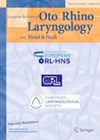
Journal Reviews
Hyaluronic acid injection laryngoplasty
This systematic review discusses the use of hyaluronic acid in injection laryngoplasties. Unilateral vocal cord paralysis leads to incomplete vocal fold adduction and dysphonia. For patients not improving with voice therapy, surgical procedures include injection laryngoplasty or open laryngeal framework...
What characterises dysphagia in unilateral vocal fold impairment?
The closure of the vocal folds during swallowing is known to contribute to airway protection along with epiglottic inversion and closure of the false vocal folds. It is therefore plausible to expect that unilateral vocal fold impairment without complete closure...
How to train adults with single-sided deafness and cochlear implants
Cochlear implantation (CI) in patients with single-sided deafness (SSD) has been carried out in Perth, Australia from 2008. It poses challenges to clinicians and patients who are trying to tune in the poorer ear while still having a normally hearing...
The paediatric dilemma of one ear in and one ear out of NICE criteria
The auditory implant team in Manchester have implanted a cohort of children where audiological thresholds meet the NICE guidance for cochlear implantation (CI) in one ear only, and the other falls into moderate, severe or sloping loss. These children are...
Rhinoplasty for the cleft lip and palate patient
The cleft nose is one of the most challenging pathologies for rhinologists and facial plastic surgeons to address. The combination of architectural deformity (related to the extent of lip deformity) and scarring from previous surgery combine to cause the surgical...
Cosmesis of the nose in cleft lip and palate
The cleft nose is one of the most challenging pathologies for rhinologists and facial plastic surgeons to address. The combination of architectural deformity (related to the extent of lip deformity) and scarring from previous surgery combine to cause the surgical...
Two for the price of one - multiple parotid neoplasms
With advancing years come many benefits, but one drawback is the acquisition of parotid (or thyroid) neoplasms. Conventional teaching is that most are benign and slowly enlarge, and not infrequently are found bilaterally as in Warthin’s. Pleomorphic adenomas are also...
Reasons for rejection of BAHA in patients with unilateral hearing loss
Ever since Tjellström first developed the procedure of BAHA implantation, the techniques have come a long way towards faster and more convenient surgical methods to offer better hearing for a wide variety of conditions. Unilateral hearing loss has now been...
The benefits of early voice therapy for unilateral vocal cord paralysis
This retrospective review of voice outcomes following a diagnosis of unilateral vocal fold paralysis divided patients into three groups according to the time of initiation of voice therapy following the onset of paralysis. The ‘early’ group started voice therapy within...
Review: Cochlear Implantation in SSD?
Contra lateral routing of signals (CROS) using hearing aids and bone conduction devices has been the conventionally accepted modality for the treatment of single sided hearing impairment. The CROS hearing aid has been found to improve speech understanding in noise,...















